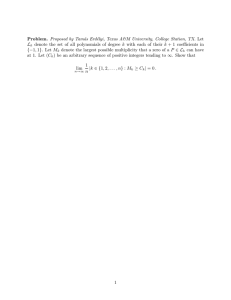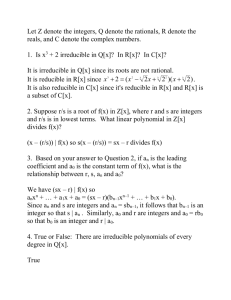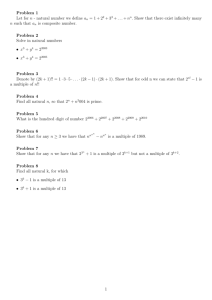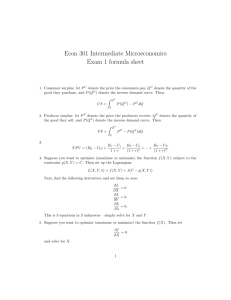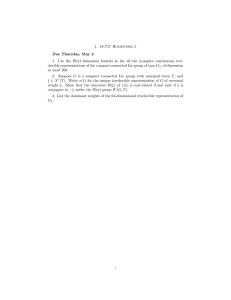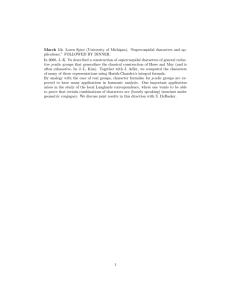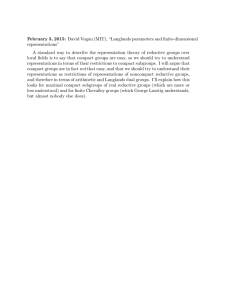Document 10553921
advertisement
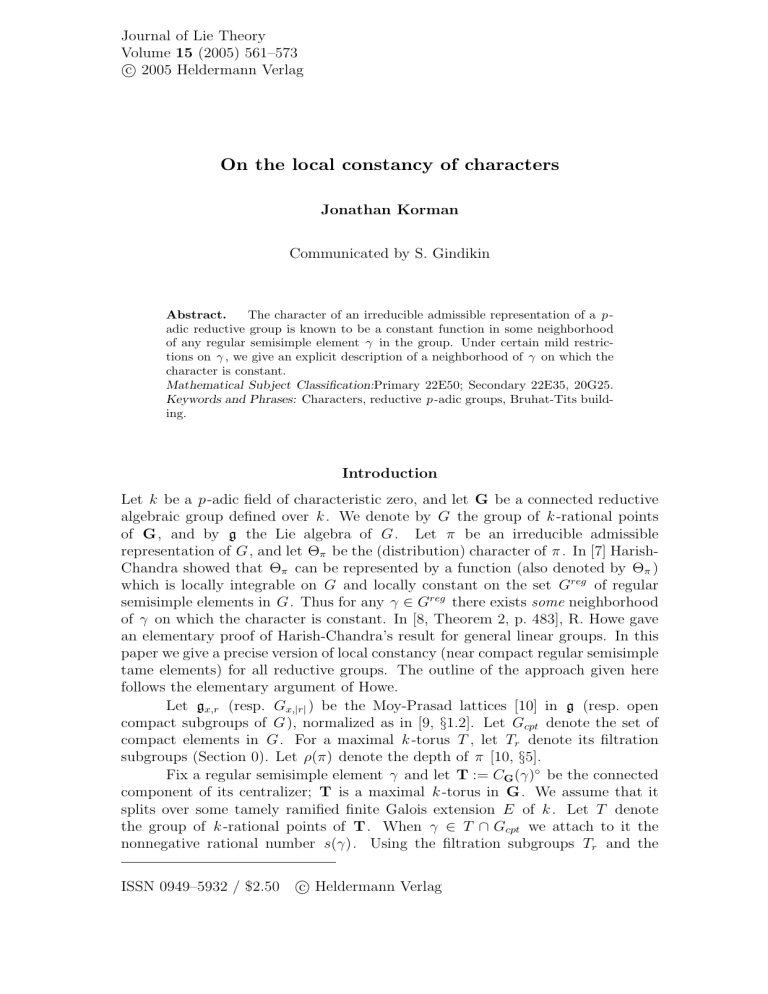
Journal of Lie Theory
Volume 15 (2005) 561–573
c 2005 Heldermann Verlag
On the local constancy of characters
Jonathan Korman
Communicated by S. Gindikin
Abstract.
The character of an irreducible admissible representation of a p adic reductive group is known to be a constant function in some neighborhood
of any regular semisimple element γ in the group. Under certain mild restrictions on γ , we give an explicit description of a neighborhood of γ on which the
character is constant.
Mathematical Subject Classification:Primary 22E50; Secondary 22E35, 20G25.
Keywords and Phrases: Characters, reductive p -adic groups, Bruhat-Tits building.
Introduction
Let k be a p-adic field of characteristic zero, and let G be a connected reductive
algebraic group defined over k . We denote by G the group of k -rational points
of G, and by g the Lie algebra of G. Let π be an irreducible admissible
representation of G, and let Θπ be the (distribution) character of π . In [7] HarishChandra showed that Θπ can be represented by a function (also denoted by Θπ )
which is locally integrable on G and locally constant on the set Greg of regular
semisimple elements in G. Thus for any γ ∈ Greg there exists some neighborhood
of γ on which the character is constant. In [8, Theorem 2, p. 483], R. Howe gave
an elementary proof of Harish-Chandra’s result for general linear groups. In this
paper we give a precise version of local constancy (near compact regular semisimple
tame elements) for all reductive groups. The outline of the approach given here
follows the elementary argument of Howe.
Let gx,r (resp. Gx,|r| ) be the Moy-Prasad lattices [10] in g (resp. open
compact subgroups of G), normalized as in [9, §1.2]. Let Gcpt denote the set of
compact elements in G. For a maximal k -torus T , let Tr denote its filtration
subgroups (Section 0). Let ρ(π) denote the depth of π [10, §5].
Fix a regular semisimple element γ and let T := CG (γ)◦ be the connected
component of its centralizer; T is a maximal k -torus in G. We assume that it
splits over some tamely ramified finite Galois extension E of k . Let T denote
the group of k -rational points of T. When γ ∈ T ∩ Gcpt we attach to it the
nonnegative rational number s(γ). Using the filtration subgroups Tr and the
ISSN 0949–5932 / $2.50
c Heldermann Verlag
562
Korman
parameter s(γ), we characterize a neighborhood of γ on which the character Θπ
is constant. Whether or not this neighborhood of constancy is maximal is not
addressed here.
The main result of this paper is the following (Theorem 4.1).
Theorem. Let r = max{s(γ), ρ(π)} + s(γ). The character Θπ is constant on
the set G (γTr+ ).
We now give a brief sketch of the proof. Let K be any open compact
subgroup of G. Decompose Θπ into a countable sum of ‘partial trace’ operators
Θd , according to the irreducible representations d of K (see Section 3). For
G = GLn , Howe proved [8, p. 499] the following key fact. If X is a compact
subset of Greg , then Θd vanishes on X for all d not in a certain finite set
F (whichR depends
only on X ). It follows (see proof of Theorem 4.1), that
P
∞
Θπ (f ) = X ( d∈F Θd )(x)f (x)dx for all
Pf ∈ Cc (X). Hence Θπ is represented
on X by the locally constant function d∈F Θd .
The main part of this paper is concerned with formulating an analogue of
the above key fact for reductive groups (see Corollary 3.5).
The rational number s(γ), defined in Section 1, is used (Corollary 3.5) to
make a precise choice of a set X and a subgroup K . Corollary 3.5 characterizes
a finite set F of representations, such that for all d not in F , Θd vanishes on X
(see Remark 3.1 for the significance of this fact). Thus the representations d ∈ F
are those which play a role in understanding the character Θπ near γ . The proof
of this corollary relies on a special case (Corollary 2.7), in which we only consider
1-dimensional d. Such representations have an explicit description in terms of
cosets in the lie algebra g. In Section 2, we develop the technical tools, using
Moy-Prasad lattices, to handle these cosets. Once we have a characterization of
the set F , we can make precise statements about the neighbourhood of constancy
of the character near γ (Theorem 4.1).
Acknowledgments. I would like to thank Fiona Murnaghan, Jeff Adler, Stephen
DeBacker, Ju-Lee Kim and Joe Repka for helpful conversations and comments.
I would also like to thank the referees for their careful reading and detailed
comments.
Notation and Conventions
Let k be a p-adic field (a finite extension of some Qp ) with residue field Fpn . Let
ν be a valuation on k normalized such that ν(k × ) = Z.
For any algebraic extension field E of k , ν extends uniquely to a valuation
(also denoted ν ) of E .
We denote the ring of integers in E by RE (write R for Rk ), and the prime
ideal in RE by ℘E (write ℘ for ℘k ).
Let G be a connected reductive group defined over k , and G(E) the group
of E -rational points of G. We denote by G the group of k -rational points of G.
Denote the Lie algebras of G and G(E) by g and g (E), respectively. Write g
for the Lie algebra of k -rational points of g.
Let N be the set of nilpotent elements in g. There are different notions of
nilpotency, but since we assume that char(k) = 0, these notions all coincide.
Let Ad (resp. ad) denote the adjoint representation of G (resp. g) on its
Korman
563
Lie algebra g. For elements g ∈ G and X ∈ g (resp. x ∈ G) we will sometimes
write g X (resp. g x) instead of Ad(g)X (resp. gxg −1 ). For a subset S of g (resp.
G) let G S denote the set {g s | g ∈ G and s ∈ S}.
Let n denote the (absolute) rank of G. We say that an element g ∈ G
is regular semisimple if the coefficient of tn in det(t − 1+Ad(g)) is nonzero. We
denote the set of regular semisimple elements in G by Greg . Similarly we say that
an element X ∈ g is regular semisimple if the coefficient of tn in det(t−ad(X)) is
nonzero. We denote the set of regular semisimple elements in g by greg . Let Gcpt
denotes the set of compact elements in G. For a subset S of G we will sometimes
write Scpt for S ∩ Gcpt .
For a subset S of g (resp. G) let [S] denote the characteristic function of
S on g (resp. G).
For any compact group K , let K ∧ denote the set of equivalence classes of
irreducible, continuous representations of K .
Let π be an irreducible admissible representation of G. We denote by Θπ
the character of π thought of as a locally constant function on the set Greg . Let
ρ(π) denote the depth of π [10, §5].
0.
Preliminaries
0.1. Apartments and buildings. For a finite extension E of k , let B(G, E)
denote the extended Bruhat-Tits building of G over E ; write B(G) for B(G, k).
It is known (e.g. [13]) that if E is a tamely ramified finite Galois extension of k
then B(G, k) can be embedded into B(G, E) and its image is equal to the set of
Galois fixed points in B(G, E). If T is a maximal k -torus in G that splits over
E , let A(T, E) be the corresponding apartment over E . Let X∗ (T, E) (resp.
X∗ (T, E)) denote the group of E -rational characters (resp. cocharacters) of T.
It is known in the tame case [1, §1.9] that there is a Galois equivariant
embedding of B(T, E) into B(G, E), which in turn induces an embedding of
B(T, k) into B(G, k). Such embeddings are only unique modulo translations by
elements of X∗ (T, k) ⊗ R, however their images are all the same and are equal
to the set A(T, E) ∩ B(G, k). From now on we fix a T -equivariant embedding
i : B(T, k) −→ B(G, k), and use it to regard B(T, k) as a subset of B(G, k); write
x for i(x).
Notation. We write A(T, k) for A(T, E) ∩ B(G, k). This is well defined
independent of the choice of E [15]. Moreover, A(T, k) is the set of Galois fixed
points in A(T, E).
We remark that the image of B(T, E) in B(G, E) is the apartment
A(T, E), while the image of B(T, k) in B(G, k) is the set A(T, k).
0.2. Moy-Prasad filtrations. Regarding G as a group over E , Moy and
Prasad (see [10] and [11]) define lattices in g (E) and subgroups of G(E).
We can and will normalize (with respect to the normalized valuation ν ) the
indexing (x, r) ∈ B(G, E) × R of these lattices and subgroups as in [9, §1.2]. We
will denote the (normalized) lattices by g (E)x,r , and the (normalized) subgroups
by G(E)x,|r| .
If $E is a uniformizing element of E , and e = e(E/k) is the ramification
index of E over k , then these normalized lattices (resp. subgroups) satisfy $E
564
Korman
g (E)x,r = g (E)x,r+ 1 . Write gx,r (resp. Gx,|r| ) for g (k)x,r (resp. G(k)x,|r| ).
e
The above normalization was chosen to have the following property [1,
1.4.1]: when E is a tamely ramified Galois extension of k and x ∈ B(G, k) ⊂
B(G, E), we have
gx,r = g(E)x,r ∩ g,
and (for r > 0) Gx,r = G(E)x,r ∩ G.
(1)
We will also use the following notation. Let r ∈ R and x ∈ B(G).
• gx,r+ = ∪s>r gx,s and Gx,|r|+ = ∪s>|r| Gx,s .
• Gr = ∪x∈B(G) Gx,r and Gr+ = ∪s>r Gs for r ≥ 0.
The lattices gx,r+ (resp. groups Gx,|r|+ ) have analogous properties to those of gx,r
(resp. Gx,|r| ). The set G0 is the set of compact elements Gcpt . We remark that
Gcpt ⊂ G(E)cpt ∩ G, and in general they need not be equal [3, §2.2.3].
Lemma 0.1.
Let γ be a compact regular semisimple element, and consider the
maximal k -torus T := CG (γ)◦ . Suppose that T splits over a tamely ramified finite
Galois extension E of k . Then γ fixes B(T, k) pointwise.
Proof.
Recall that γ acts on A(T, E) by translations [14, §1]. Since γ belongs
to a compact subgroup, it has a fixed point x ∈ B(G, E).
If γ acts on A(T, E) by a nontrivial translation, then for any y ∈ A(T, E)
there is an n ∈ N such that d(x, y) 6= d(x, γ n .y). This contradicts the fact that
the action preserves distances. So γ must act trivially on A(T, E). In particular,
γ fixes A(T, k), and hence B(T, k), pointwise.
0.3. Root decomposition. Let T be a maximal k -torus in G that splits over
a tamely ramified finite Galois extension E of k . Let Φ(T, E) denote the set of
roots of G with respect to E and T, and let Ψ(T, E) denote the corresponding set
of affine roots of G with respect to E , T and ν . When T is k -split, we also write
Φ(T) for Φ(T, k) (resp. Ψ(T) for Ψ(T, k)). If ψ ∈ Ψ(T, E), let ψ̇ ∈ Φ(T, E) be
the gradient of ψ , and let g (E)ψ̇ ⊂ g(E) be the root space corresponding to ψ̇ .
We denote the root lattice in g(E)ψ̇ corresponding to ψ by g(E)ψ [10, 3.2].
For x ∈ A(T, E) and r ∈ R, let t(E)r := t(E) ∩ g(E)x,r and t(E)r+ :=
t(E) ∩ g(E)x,r+ . Note that t(E)r and t(E)r+ are defined independent of the
choice of x ∈ A(T, E). Similarly one defines the subgroups T(E)r and T(E)r+
for r ≥ 0; they have analogous properties. Note that using our conventions we
will sometimes denote T(E)0 by T(E)cpt .
An alternative description is [9, §2.1]: for r ∈ R,
t(E)r = {Γ ∈ t(E)| ν(dχ(Γ)) ≥ r for all χ ∈ X∗ (T, E)}
and for r > 0,
T(E)r = {t ∈ T(E)| ν(χ(t) − 1) ≥ r for all χ ∈ X∗ (T, E)}.
565
Korman
Since G splits over E , we have
X
g(E)x,r = t(E)r ⊕
g(E)ψ ,
ψ∈Ψ(T,E),ψ(x)≥r
X
g(E)x,r+ = t(E)r+ ⊕
g(E)ψ .
ψ∈Ψ(T,E),ψ(x)>r
Let t := Lie(T ), and define t⊥ := (Ad(γ) − 1)g. We have the following
decomposition [7, §18]
g = t ⊕ t⊥ .
(2)
We write X = Y + Z with respect to this decomposition; when convenient, we
also write Xt for Y .
Fix x ∈ B(T, k) ⊂ B(G, k) and r ∈ R. Write tr for t ∩ gx,r (resp. tr+
for t ∩ gx,r+ ); as mentioned earlier, these definitions are independent of x. Define
⊥
⊥
⊥
t⊥
x,r := t ∩ gx,r (resp. tx,r+ := t ∩ gx,r+ ). We have [1, 1.9.3],
gx,r
gx,r+
= tr ⊕ t⊥
x,r ,
= tr+ ⊕ t⊥
x,r+ .
(3)
0.4. Hypotheses.
(HB) There is a nondegenerate G-invariant symmetric bilinear form B on g
such that we can identify g∗x,r with gx,r via the map Ω : g → g∗ defined by
Ω(X)(Y ) = B(X, Y ).
Groups satisfying the above hypothesis are discussed in [4, §4].
Fix r ∈ R>0 and x ∈ B(G, k). For any r ≤ t ≤ 2r the group (Gx,r /Gx,t )
is abelian. By hypothesis (HB), there exists a (Gx,0 -equivariant) isomorphism
(see [1, §1.7] or [12, p.16])
(Gx,r /Gx,t )∧ ∼
= gx,(−t)+ /gx,(−r)+ .
1.
(4)
Regular depth
From now on let γ ∈ Greg , and assume that the k -torus T := CG (γ)◦ splits over
a tamely ramified finite Galois extension E of k . We attach to γ the following
rational number s(γ).
Definition 1.1.
For each α ∈ Φ(T, E) let sα (γ) := ν(α(γ) − 1) and define
s(γ) := max{ sα (γ) | α ∈ Φ(T, E) }.
Remark 1.2.
Note that s(γ) is not the same as the depth of γ (as defined
in [2]). But for good elements [1, §2.2], these two notions agree.
Remark 1.3.
A priori s(γ) ∈ Q ∪ {+∞}, but since γ is regular, α(γ) 6= 1 for
all α ∈ Φ(T, E) and so s(γ) ∈ Q. If γ is compact then s(γ) ≥ 0. Also note that
s(γz) = s(γ) for all z in the center Z(G) of G and that s(gγg −1 ) = s(γ) for all
g ∈ G.
We will need the following basic properties of s(γ).
566
Korman
Lemma 1.4.
Suppose γ ∈ Tcpt and γ 0 ∈ Ts(γ)+ .
1. s(γγ 0 ) = s(γ) and for α ∈ Φ(T, E), we have |α(γγ 0 ) − 1| = |α(γ) − 1|.
2. γγ 0 ∈ Tcpt .
Proof.
1. Fix r > s(γ) ≥ 0 such that Tr = Ts(γ)+ . With this notation
γ 0 ∈ Tr . By the alternative description of Tr , for any χ ∈ X∗ (T, E),
χ(γ 0 ) = 1 + µ0 where ν(µ0 ) ≥ r . Thus for any α ∈ Φ(T, E), α(γ 0 ) = 1 + λ0
where ν(λ0 ) ≥ r .
×
. Since
Note that since each α ∈ Φ(T, E) is continuous, α(T (E)cpt ) ⊂ RE
γ ∈ Tcpt ⊂ T (E)cpt we get that α(γ) is a unit.
Now α(γγ 0 )−1 = α(γ)α(γ 0 )−1 = α(γ)(1+λ0 )−1 = (α(γ)−1)+α(γ)λ0 . Using
ν(α(γ) − 1) =: sα (γ), α(γ) is a unit, and ν(λ0 ) ≥ r > s(γ) ≥ sα (γ), we have
ν(α(γγ 0 )−1) = ν(α(γ)−1)) (or equivalently |α(γγ 0 )−1| = |α(γ)−1)|) for all
α ∈ Φ(T, E). Thus s(γγ 0 ) := max{ν(α(γγ 0 ) − 1)} = max{ν(α(γ) − 1)} =:
α
α
s(γ).
2. Since γ and γ 0 are in Tcpt , so is their product.
Corollary 1.5.
γTs(γ)+ ⊂ Greg .
Proof.
Let γ ∈ T be a compact regular semisimple element. Then
For t ∈ T ∩ Greg , following [7, §18], define
Y
DG/T (t) := det (Ad(t) − 1)) |g/t =
(α(t) − 1).
α∈Φ(T,E)
Then t ∈ T ∩ Greg ⇔ DG/T (t) 6= 0 ⇔ |DG/T (t)| Q
=
6 0. Using Lemma
Q 1.4 with
γ ∈ T ∩ Gcpt and γ 0 ∈ Ts(γ)+ , we get |DG/T (γγ 0 )| = |α(γγ 0 ) − 1| = |α(γ) − 1| =
α
α
|DG/T (γ)| =
6 0.
2.
Some Technical Lemmas
The next lemma will generalize the following example.
G = GL2 , T a k -split maximal torus. Choose x0 ∈B(G,
k)
0
x
so that Gx0 ,0 = GL2 (R). Any X ∈ N ∩ (gx0 ,r r gx0 ,r+ ) is of the form k
,
0 0
for some k ∈ Gx0 ,0 (see [5, 9.2.1]). Thus
−1
a b
0 x
a b
X =
c d
0 0
c d
2
x
−ac a
=
.
ad − bc −c2 ac
Example 2.1.
Write X = Y + Z as in (2) and note that the depth of X with respect
to the filtration {gx0 ,r }r∈R of g is controlled by Z . This is the case since
max{ν(a2 ), ν(−c2 )} ≥ ν(ac) and ad − bc ∈ R× .
567
Korman
Lemma 2.2.
Fix x ∈ B(T, k) and r ∈ R. For X ∈ N ∩ (gx,r r gx,r+ ), write
X = Y + Z as in (2). Then Z ∈ gx,r r gx,r+ .
Proof.
We first prove the case when the maximal k -torus T is k -split and
then reduce the general case to this case.
Split case. Assume T is k -split. Note that t⊥ = ⊕α∈Φ(T) gα . Fix a
system of simple roots ∆ in Φ(T) and choose a Chevalley basis for g as in [1,
§1.2]. Such a basis contains elements Hb and Eb in g for each b ∈ Φ(T). If G
is semisimple, then the set {Hb | b ∈ ∆} ∪ {Eb | b ∈ Φ(T)} is a basis for g. These
elements also satisfy the commutation relations listed in [1, 1.2.1]. With respect
to this choice of Chevalley basis, the adjoint representation is determined by the
following formulas [1, 1.2.5]:
Ad(eb (λ))Ec
=
Ad(t)Ec
Ad(e
b (λ))H
Ad(t)H
=
=
=
Eb
Ec + λHb − λ2 Eb
P
i
i≥0 Mb,c;i λ Eib+c
c(t)Ec
H − db(H)λEb
H
if
if
if
c=b
c = −b
c 6= ±b
(5)
for all H ∈ Lie(T ), all t ∈ T and all λ ∈ k . Here eb is the unique map
eb : Add −→ G such that deb (1) = Eb (deb is the derivative of eb ); and Mb,c;i
are constants with Mb,c;0 = 1.
Let B be the Borel subgroup associated to ∆ (with Levi decomposition
B = T N and opposite Borel B = T N ). We have g = t ⊕ n ⊕ n, where n := Lie(N )
and n := Lie(N ). Note that n ⊕ n = ⊕α∈Φ(T) gα = t⊥ . Recall that Gx,0 acts on
gx,r (and on gx,r+ ).
Given X ∈ N ∩ (gx,r r gx,r+ ), we can use [2, Proposition 3.5.1] (with T
playing the role of M ) to conclude that there exists a group element n ∈ N ∩ Gx,0
such that (n X)t ∈ tr+ (where n X denotes Ad(n)X ).
Write X = Y + Z as in (2) and assume for a contradiction that Z ∈ gx,r+ .
Since X ∈ gx,r rgx,r+ , the assumption implies that Y ∈ t∩(gx,r rgx,r+ ) = tr rtr+ .
Using the properties (5) of the Chevalley basis, one can easily check that
the set (tr r tr+ ) ⊕ n is preserved under the action of Ad(eb (λ)) for all b ∈ Φ+ (T),
where Φ+ (T) are the positive roots with respect to ∆. Since {eb (λ) | b ∈ Φ+ (T)}
generates N , we conclude that n Y ∈ (tr rtr+ )⊕n, and hence that (n Y )t ∈ tr rtr+ .
On the other hand we have n X = n Y + n Z , where n Z ∈ gx,r+ . Taking the t
components, we get, (n X)t = (n Y )t + (n Z)t , with (n Z)t ∈ tr+ . Since (n X)t ∈ tr+ ,
we conclude that (n Y )t ∈ tr+ . This contradicts (n Y )t ∈ tr r tr+ .
Hence Z ∈ gx,r r gx,r+ (note that from the decomposition (3) it is clear
that Z ∈ gx,r ).
General case. We now assume T is an E -split maximal k -torus. Define
⊥
t(E) := (Ad(γ) − 1)g(E). We have the following analogue of (2)
g(E) = t(E) ⊕ t(E)⊥ .
(6)
Note that t ⊂ t(E) and t⊥ ⊂ t(E)⊥ . So the decomposition X = Y +Z (as in (2))
for X ∈ g is the same whether viewed in g or in g(E).
568
Korman
Since X ∈ gx,r rgx,r+ , equations (1) imply that X ∈ (g(E)x,r r g(E)x,r+ )∩
g. Since X ∈ N ⊂ N (E) (where N (E) is the set of nilpotent elements in g(E)),
we have that X ∈ N (E) ∩ (g(E)x,r r g(E)x,r+ ). Now since T splits over E we
can regard G over E as a split group and hence apply all the constructions of the
split case above. So by the considerations of the split case above we conclude that
Z ∈ g(E)x,r r g(E)x,r+ . Intersecting with g gives Z ∈ gx,r r gx,r+ .
From now on we assume that γ is also compact. Recall that this implies
that s(γ) ≥ 0 (see Remark 1.3).
Lemma 2.3.
Let t ∈ R and x ∈ B(T, k). If Z ∈ t⊥ ∩ (gx,−t r gx,(−t)+ ) then
γ
Z − Z 6∈ gx,(−t+s(γ))+ .
⊥
⊥
Proof.
Using the root
decomposition t(E)P
= ⊕α∈Φ(T,E) g(E)
α , for Z ∈ t ⊂
P
P
t(E)⊥ we write Z = Zα . Then γ Z − Z = (γ Zα − Zα ) = (α(γ) − 1)Zα .
By assumption Z 6∈ gx,(−t)+ , hence (see equations (1)) Z 6∈ g(E)x,(−t)+ .
Thus for some α ∈ Φ(T, E), Zα 6∈ g(E)x,(−t)+ , and so by definition of sα (γ),
(α(γ) − 1)Zα 6∈ g(E)x,(−t+sα (γ))+ . It follows P
by definition of s(γ), that (α(γ) −
1)Zα 6∈ g(E)x,(−t+s(γ))+ . Hence γ Z − Z =
(α(γ) − 1)Zα 6∈ g(E)x,(−t+s(γ))+ .
γ
Intersecting with g we get that Z − Z 6∈ gx,(−t+s(γ))+ .
Proposition 2.4.
Let r ∈ R and x ∈ B(T, k). If X ∈ N ∩ gx,(−2r)+ satisfies
γ
X − X ∈ gx,(−r)+ , then X ∈ gx,(−r−s(γ))+ .
Proof.
Fix t < 2r such that X ∈ N ∩ (gx,−t r gx,(−t)+ ).
Write X = Y + Z as in (2). By Lemma 2.2, Z ∈ t⊥ ∩ (gx,−t r gx,(−t)+ ), and
so by Lemma 2.3, γ Z − Z 6∈ gx,(−t+s(γ))+ .
On the other hand, since γ acts trivially on Y (because Y ∈ t = Cg (γ)),
γ
Z − Z = γ X − X ∈ gx,(−r)+ .
Thus −t + s(γ) > −r , or equivalently −t > −r − s(γ), which implies that
X ∈ gx,−t ⊆ gx,(−r−s(γ))+ .
Definition 2.5.
A character d ∈ (Gx,r /Gx,2r )∧ is called degenerate if under the
isomorphism (4), the corresponding coset X +gx,(−r)+ contains nilpotent elements.
Definition 2.6.
Let K be a compact subgroup of G and d ∈ K ∧ . For g ∈ G,
let g d denote the representation of gKg −1 defined as g d(gkg −1 ) := d(k). We say
that g intertwines d with itself if upon restriction to gKg −1 ∩K , d and g d contain
a common representation (up to isomorphism) of gKg −1 ∩ K .
Corollary 2.7.
Let x ∈ B(T, k), r ∈ R>0 , and assume d ∈ (Gx,r /Gx,2r )∧ is
degenerate. If γ intertwines d with itself then d ∈ (Gx,r /Gx,r+s(γ) )∧ .
Proof.
Let X + gx,(−r)+ be the coset in gx,(−2r)+ /gx,(−r)+ corresponding to d
under the isomorphism (4). Since this coset is degenerate, we can assume that
X ∈N.
Since γ fixes x (Lemma 0.1), γ stabilizes Gx,r . Thus having γ intertwine d
with itself amounts to having d ∼
= γ d; or furthermore, since d is one-dimensional,
d = γ d. Under the isomorphism (4), we get X +gx,(−r)+ = γ (X +gx,(−r)+ ), or equivalently that γ X − X ∈ gx,(−r)+ . Now apply Proposition 2.4 to conclude that X ∈
gx,(−r−s(γ))+ , which under the isomorphism (4) gives that d ∈ (Gx,r /Gx,r+s(γ) )∧ .
Korman
3.
569
Partial Traces
Let (π, V ) be an irreducible admissible
L representation of G. Let K be an open
compact subgroup of G. Let V = d∈K ∧ Vd be the decomposition of V into K isotypic components. Let Ed denote the K -equivariant projection from V to Vd .
For f ∈ Cc∞ (G) define the distribution Θd (f ) := trace (Ed π(f ) Ed ), the ‘partial
trace of π with respect to d’. The distribution Θd is represented by the locally
constant function Θd (x) := trace (Ed π(x) Ed ) on G. Recall that it is known
that the distribution Θπ (f ) := trace π(f ) is also represented by a locally constant
function, Θπ , on Greg ; we will not use this fact here. It follows from the definitions
that as distributions
X
Θd (f ) for all f ∈ Cc∞ (G).
Θπ (f ) =
d∈K ∧
Remark 3.1.
For (some) ω ⊂ Greg compact, Corollary 3.6 and the proof of
Theorem 4.1 will imply that, for all f ∈ Cc∞ (ω), this sum is finite.
Lemma 3.2.
Proof.
Θd (kxk −1 ) = Θd (x) for all x ∈ G and all k ∈ K .
Since Ed is K -equivariant, it commutes with π(k) for all k ∈ K .
Θd (kxk −1 ) =
=
=
=
trace(Ed π(kxk −1 )Ed )
trace(Ed π(k)π(x)π(k −1 )Ed )
trace(π(k)Ed π(x)Ed π(k −1 ))
trace(Ed π(x)Ed ) = Θd (x).
Let N be an open compact subgroup of G which is normal in K . Suppose
g ∈ G normalizes K and N . Let d ∈ K ∧ . Considered as a representation of N ,
d decomposes into a finite sum of irreducible representations
d1 ⊕ · · · ⊕ dn .
Proposition 3.3.
Suppose Θd (g) 6= 0. Then d ∼
= g d as representations of K
and also for some i ∈ {1, · · · , n}, di ∼
= g di as representations of N .
Proof.
We refer to the appendix. Since g permutes the Vd0 ’s (Theorem 5.1.1),
0 6= Θd (g) = trace(Ed π(g)Ed ) implies that g must stabilize Vd . Fix a decomposition (‡) as in TheoremP5.1.2, and let EWi denote the K -equivariant projections
onto Wi . Since Ed =
EWi , trace(Ed π(g)Ed ) 6= 0 implies that for some i, g
must stabilize Wi , and that trace(EWi π(g)EWi ) 6= 0. By Theorem 5.1.3, d ∼
= g d,
which proves the first part of the theorem.
Now as a representation of N ,
M
Wi =
Wi,dj ,
N
j
where Wi,dj are the dj -isotypic components of Wi . Since gPstabilizes N , it
must permute the Wi,dj ’s (Theorem 5.1.1). Since EWi =
EWi,dj , having
570
Korman
trace(EWi π(g)EWi ) 6= 0 implies that for some j , g must stabilize Wi,dj , and
that trace(EWi,dj π(g)EWi,dj ) 6= 0. Fix a decomposition (‡) as in Theorem 5.1.2 for
Wi,dj :
M
Wi,d ∼
dj .
=
j
N
P
Since EWi,dj =
Edj , trace(EWi,dj π(g)EWi,dj ) 6= 0 implies that g must stabilize
one of the dj ’s. By Theorem 5.1.3, dj ∼
= g dj , which proves the second part of the
theorem.
The following theorem and corollaries are used
P in the proof of Theorem 4.1
to show that for f with compact support, the sum d∈K ∧ Θd (f ) is finite (see also
Remark 3.1).
Theorem 3.4.
Fix x ∈ B(T, k) and let r > max{s(γ), ρ(π)}. If d ∈ (Gx,r )∧
satisfies Θd (γ) 6= 0, then d ∈ (Gx,r /Gx,r+s(γ) )∧ .
Proof.
If d is trivial we are done, so assume it is not. Let t be the smallest
number such that d|Gx,t+ is trivial (so in particular d|Gx,t is nontrivial).
Case t < 2r : Pick s ≤ 2r such that Gx,s = Gx,t+ . Consider d as an
element of (Gx,r /Gx,2r )∧ . By Proposition 3.3, Θd (γ) 6= 0 implies that d ∼
= γ d.
Also, Θd (γ) 6= 0 implies that d ⊂ π|Gx,r ; since r > ρ(π) this means that d is
degenerate (see [5, §7.6]). Now apply Corollary 2.7.
Case t ≥ 2r : Note that 2t ≥ r > s(γ). For > 0 such that 2t > 2 +s(γ), let
s = t + . By making smaller if necessary, we can make sure that Gx,s = Gx,t+ .
Note that t > 2t + 2 + s(γ) = 2s + s(γ).
Since 2s > 2t ≥ r it makes sense to restrict d to Gx, 2s and think of it as an
element of (Gx, 2s /Gx,s )∧ . As a representation of Gx, 2s /Gx,s , d decomposes into a
finite sum of irreducible (one-dimensional) representations
d1 ⊕ · · · ⊕ dn .
Let Xi +gx,(− 2s )+ be the coset in gx,(−s)+ /gx,(− 2s )+ corresponding to di under
the isomorphism (4).
By Proposition 3.3, 0 6= Θd (γ) implies that for some j , dj ∼
= γ dj .
Now d ⊂ π|Gx,r , implies that dj ⊂ π|Gx, s and since 2s > r > ρ(π)
2
we have that dj is degenerate. Apply Corollary 2.7 to dj to conclude that
dj ∈ (Gx, 2s /Gx, 2s +s(γ) )∧ . In particular dj is trivial on Gx, 2s +s(γ) , and hence on
Gx,t .
Since Gx,r normalizes Gx, 2s , it acts by permutations on the di ’s. Since d is
irreducible, this action is transitive. Hence all the di ’s are conjugate by elements
of Gx,r . By the conjugation of the di ’s and the fact that dj |Gx,t = 1 it follows
that di |Gx,t = 1 for all i, and so d itself is trivial on Gx,t . This contradicts the
definition of t. Hence this case is not possible and t < 2r .
Corollary 3.5.
Fix x ∈ B(T, k) and let r > max{s(γ), ρ(π)}. Let X denote
γTr+s(γ) , a compact subset of T ∩ Greg . If d ∈ (Gx,r )∧ satisfies Θd (γ 0 ) 6= 0 for
some γ 0 ∈ X , then d ∈ (Gx,r /Gx,r+s(γ) )∧ .
571
Korman
Proof.
Lemma 1.4 implies that γ 0 fixes x and that s(γ 0 )=s(γ). Now apply
Theorem 3.4 to γ 0 .
Corollary 3.6.
Fix x ∈ B(T, k) and let r > max{s(γ), ρ(π)}. Let ω denote
Gx,r
(γTr+s(γ) ), an open compact subset of Greg . Then Θd vanishes on ω for
all d ∈
/ (Gx,r /Gx,r+s(γ) )∧ . Furthermore, Θd (x) = Θd (γ) for all x ∈ ω and all
d ∈ (Gx,r /Gx,r+s(γ) )∧ .
Proof.
Follows immediately from Lemma 3.2 and Corollary 3.5.
4.
Proof of the Main Theorem
Let r > max{s(γ), ρ(π)}. Denote the finite set (Gx,r /Gx,r+s(γ) )∧ by F .
Theorem 4.1.
The distribution Θπ is represented on the set
constant function.
G
(γTr+s(γ) ) by a
Proof.
Using Corollary 3.6, we have for all f ∈ Cc∞ (G) whose support is
contained in ω ,
XZ
XZ
X
Θd (x)f (x)dx =
Θd (γ)f (x)dx
Θπ (f ) =
Θd (f ) =
d∈(Gx,r )∧
ω
d∈F
d∈F
ω
!
Z
X
=
ω
Θd (γ) f (x)dx.
d∈F
P
Thus
Θ
is
represented
by
the
constant
function
π
d∈F Θd (γ) on ω , i.e. Θπ (x) =
P
Θ
(γ)
for
all
x
∈
ω
.
Since
Θ
is
conjugation
invariant,
we get Θπ (gxg −1 ) =
dP
π
d∈F
Θπ (x) = d∈F Θd (γ) for all x ∈ ω and all g ∈ G.
Remark 4.2.
This gives a new proof of the local constancy (near compact
regular semisimple tame elements γ ) of the character of an irreducible admissible
representation for an arbitrary reductive p-adic group G.
5.
Appendix
We prove some variations of Clifford theory [6, §14]. Let K and N be open
compact subgroups of G, such that N is a normal subgroup of K . Let (π, V ) be
an irreducible admissible representation of G and let
M
V =
Vd
(†)
K
d∈K ∧
be the (canonical) decomposition of V into K -isotypic components. Here Vd
denotes the d-isotypic component of V , i.e. the sum of all the K -submodules
of V isomorphic to d = (d, W ). Each isotypic component Vd decomposes (noncanonically) into a finite sum of isomorphic copies Wi ∼
= W of (d, W )
K
Vd ∼
=
K
M
i
Wi .
(‡)
572
Korman
Theorem 5.1.
Suppose g ∈ G normalizes K and N . Then
1. The action of g permutes the Vd ’s.
2. Suppose g stabilizes Vd . Then there exists a decomposition (‡) such that the
action of g permutes the Wi .
3. Suppose W 0 is a K -submodule of V , isomorphic to W , and stable under the
action g . Then g d ∼
= d.
Proof.
1. This follows from the fact that for any two K -submodules W 0
and W 00 of V , if W 0 ∼
= W 00 then gW 0 ∼
= gW 00 .
K
K
2. Let W 0 be an irreducible K -submodule of Vd , isomorphic to W . Since g
normalizes K and stabilizes Vd , gW 0 is a K -submodule of Vd . Since W 0
is irreducible, so is gW 0 . As an irreducible submodule of Vd , gW 0 must be
isomorphic to W . By irreducibility either W 0 ∩ gW 0 = {0} or W 0 = gW 0 .
Thus the orbit of W 0 under g is a collection of subspaces with trivial pairwise
intersection, and so g acts on their sum as a desired. By complete reducibility
of Vd (being a finite-dimensional representation of the compact group K )
we can now use induction on the dimension of Vd .
3. This follows from the following commutative diagram (in which all the arrows
are isomorphisms of vector spaces and k ∈ K ).
π(g)
W 0 −−−→ W
g
g
π(k )y
d(k )yg d(k)
π(g)
W 0 −−−→ W
W −−−→ W 0 −−−→ gW 0
−1
d(k)y
π(k)y
π(gkg )y
W −−−→ W 0 −−−→ gW 0
References
[1]
[2]
[3]
[4]
[5]
[6]
Adler, J., Refined anisotropic K -types and supercuspidal representations,
Pacific J. Math. 185 (1998), 1–32.
Adler, J., and S. DeBacker, Some applications of Bruhat-Tits theory to
harmonic analysis on the Lie algebra of a reductive p-adic group, Michigan
Math. J. 50 (2002), 263–286.
—, Murnaghan-Kirillov theory for supercuspidal representations of tame
general linear groups, J. Reine Angew. Math. 575 (2004), 1–35.
Adler, J., and A. Roche, An intertwining result for p-adic groups, Canad.
J. Math. 52 (2000), 449–467.
DeBacker, S., Lectures on harmonic analysis for reductive p-adic groups,
Representation Theory of Lie Groups, Institute of Mathematical Sciences,
National University of Singapore, 2002, see
http://www.math.lsa.umich.edu/∼smdbackr/MATH/singfinal.pdf.
Dornhoff, L., “Group representation theory, Part A, ” Pure and Applied
Mathematics 7, Marcel Dekker Inc., 1971.
Korman
[7]
[8]
[9]
[10]
[11]
[12]
[13]
[14]
[15]
573
Harish-Chandra, Admissible invariant distributions on reductive p-adic
groups, Notes by Stephen DeBacker and Paul J. Sally, Amer. Math. Soc.
University Lecture Series, 16, 1999.
Howe, R., Some qualitative results on the representation theory of GLn
over a p-adic field, Pacific J. Math. 73 (1977), 479–538.
Kim, J.-L., and F. Murnaghan, Character expansions and unrefined minimal K -types, Amer. J. Math. 125 (2003), 1199–1234.
Moy, A., and G. Prasad, Unrefined minimal K -types for p-adic groups,
Inv. Math. 116 (1994), 393–408.
—, Jacquet functors and unrefined minimal K -types, Comment. Math.
Helvetici 71 (1996), 98–121.
Murnaghan, F., Characters of admissible representations of reductive padic groups, Lecture Notes for the Thematic Year 1999 on Number Theory
at the CRM, Montreal, 1–26.
Prasad, G., Galois fixed points in the Bruhat-Tits buildings of a reductive
group, Bull. Soc. Math. France 129 (2001), 169–174.
Tits, J., Reductive groups over local fields, in: Automorphic Forms, Representation and L-functions, Proc. Symp. Pure Math. 33–1 (1979), 29–69.
Yu, J.-K., Construction of tame supercuspidal representations, J. Amer.
Math. Soc. 14 (2001), 579–622.
Jonathan Korman
Department of Mathematics
University of Toronto
Toronto, Ontario, Canada M5S 3G3
jkorman@math.toronto.edu
Received January 24, 2005
and in final form March 19, 2005
